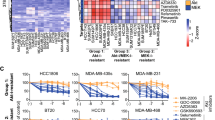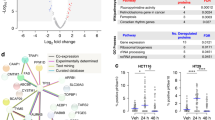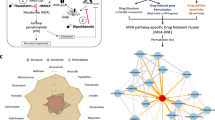One of actively developing trends in modern pharmacology is the use of the transcriptome analysis for drug repositioning. We have previously detected two molecular markers of relapses in patients with malignant breast tumors: ELOVL5 and IGFBP6. Poor prognosis is associated with low expression of these markers. Here we analyze the effects of simvastatin and a new potential proteasome inhibitor K7174 inducing expression of IGFBP6 and EVOVL5 on the proliferation of breast cancer cells MDA-MB-231 and DU4475. Compound K7174 potentiates the inhibitory effect of simvastatin on the proliferation of DU4475 cells characterized by low expression of ELOVL5-IGFBP6 pair, but not on the proliferation of MDA-MB-231 cells with high expression of these markers.
Similar content being viewed by others
References
Fujiwara T, Ikeda T, Nagasaka Y, Okitsu Y, Katsuoka Y, Fukuhara N, Onishi Y, Ishizawa K, Ichinohasama R, Tomosugi N, Harigae H. A low-molecular-weight compound K7174 represses hepcidin: possible therapeutic strategy against anemia of chronic disease. PLoS One. 2013;8(9):e75568. doi: https://doi.org/10.1371/journal.pone.0075568.
Galatenko VV, Shkurnikov MY, Samatov TR, Galatenko AV, Mityakina IA, Kaprin AD, Schumacher U, Tonevitsky AG. Highly informative marker sets consisting of genes with low individual degree of differential expression. Sci. Rep. 2015;5. ID 14967. doi: https://doi.org/10.1038/srep14967.
Gerber B, Freund M, Reimer T. Recurrent breast cancer: treatment strategies for maintaining and prolonging good quality of life. Dtsch. Arztebl. Int. 2010;107(6):85-91.
Kim JH, Scialli AR. Thalidomide: the tragedy of birth defects and the effective treatment of disease. Toxicol. Sci. 2011;122(1):1-6.
Medina-Franco JL, Giulianotti MA, Welmaker GS, Houghten RA. Shifting from the single to the multitarget paradigm in drug discovery. Drug Discov. Today. 2013;18(9-10):495-501.
Palumbo A, Facon T, Sonneveld P, Bladè J, Offidani M, Gay F, Moreau P, Waage A, Spencer A, Ludwig H, Boccadoro M, Harousseau JL. Thalidomide for treatment of multiple myeloma: 10 years later. Blood. 2008;111(8):3968-3977.
Poloznikov A, Gazaryan I, Shkurnikov M, Nikulin S, Drapkina O, Baranova A, Tonevitsky A. In vitro and in silico liver models: current trends, challenges and opportunities. ALTEX. 2018;35(3):397-412.
Sawada R, Iwata M, Tabei Y, Yamato H, Yamanishi Y. Predicting inhibitory and activatory drug targets by chemically and genetically perturbed transcriptome signatures. Sci. Rep. 2018;8(1):156.
Scannell JW, Blanckley A, Boldon H, Warrington B. Diagnosing the decline in pharmaceutical R&D efficiency. Nat. Rev. Drug Discov. 2012;11(3):191-200.
Takeda I, Maruya S, Shirasaki T, Mizukami H, Takahata T, Myers JN, Kakehata S, Yagihashi S, Shinkawa H. Simvastatin inactivates beta1-integrin and extracellular signal-related kinase signaling and inhibits cell proliferation in head and neck squamous cell carcinoma cells. Cancer Sci. 2007;98(6):890-899.
Valastyan S, Weinberg RA. Tumor Metastasis: molecular insights and evolving paradigms. Cell. 2011;147(2):275-292.
Valentiner U, Hall DM, Brooks SA, Schumacher U. HPA binding and metastasis formation of human breast cancer cell lines transplanted into severe combined immunodeficient (scid) mice. Cancer Lett. 2005;219(2):233-242.
Verbist B, Klambauer G, Vervoort L, Talloen W; QSTAR Consortium, Shkedy Z, Thas O, Bender A, Göhlmann HW, Hochreiter S. Using transcriptomics to guide lead optimization in drug discovery projects: Lessons learned from the QSTAR project. Drug Discov. Today 2015;20(5):505-513.
Zakhariants AA, Burmistrova OA, Shkurnikov MY, Poloznikov AA, Sakharov DA. Development of a specific substrate-inhibitor panel (Liver-on-a-Chip) for evaluation of cytochrome P450 activity. Bull. Exp. Biol. Med. 2016;162(1):170-174.
Zakharyants AA, Burmistrova OA, Poloznikov AA. The use of human liver cell model and cytochrome P450 substrateinhibitor panel for studies of dasatinib and warfarin interactions. Bull. Exp. Biol. Med. 2017;162(4):515-519.
Author information
Authors and Affiliations
Corresponding author
Additional information
Translated from Byulleten’ Eksperimental’noi Biologii i Meditsiny, Vol. 166, No. 11, pp. 603-608, November, 2018
Rights and permissions
About this article
Cite this article
Shkurnikov, M.Y., Poloznikov, A.A., Nikulin, S.V. et al. Transcriptome Guided Drug Combination Suppresses Proliferation of Breast Cancer Cells. Bull Exp Biol Med 166, 656–660 (2019). https://doi.org/10.1007/s10517-019-04412-4
Received:
Published:
Issue Date:
DOI: https://doi.org/10.1007/s10517-019-04412-4




